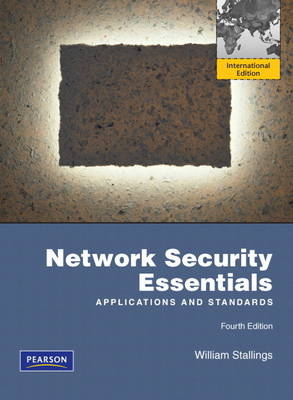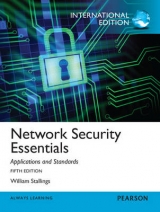
Network Security Essentials
Pearson (Verlag)
978-0-13-706792-3 (ISBN)
- Titel erscheint in neuer Auflage
- Artikel merken
In this age of universal electronic connectivity, viruses and hackers, electronic eavesdropping, and electronic fraud, security is paramount. Network Security: Applications and Standards, 4/e provides a practical survey of network security applications and standards, with an emphasis on applications that are widely used on the Internet and for corporate networks. An unparalleled support package for instructors and students ensures a successful teaching and learning experience.
Adapted from Cryptography and Network Security, Fifth Edition, this text covers the same topics but with a much more concise treatment of cryptography. Network Security, 4/e also covers SNMP security, which is not covered in the fifth edition.
Highlights include: expanded coverage of pseudorandom number generation; new coverage of federated identity, HTTPS, Secure Shell (SSH) and wireless network security; completely rewritten and updated coverage of IPsec; and a new chapter on legal and ethical issues.
William Stallings has made a unique contribution to understanding the broad sweep of technical developments in computer networking and computer architecture. He has authored 18 titles, and counting revised editions, a total of 35 books on various aspects of these subjects. In over 20 years in the field, he has been a technical contributor, technical manager, and an executive with several high-technology firms. Currently he is an independent consultant whose clients have included computer and networking manufacturers and customers, software development firms, and leading-edge government research institutions. He has received the prize for best Computer Science and Engineering textbook of the year from the Textbook and Academic Authors Association six times. Bill has designed and implemented both TCP/IP-based and OSI-based protocol suites on a variety of computers and operating systems, ranging from microcomputers to mainframes. As a consultant, he has advised government agencies, computer and software vendors, and major users on the design, selection, and use of networking software and products. Dr. Stallings holds a Ph.D. from M.I.T. in Computer Science and a B.S. from Notre Dame in Electrical Engineering.
About the Author
Preface
Chapter 1 Introduction
1.1 Computer Security Concepts
1.2 The OSI Security Architecture
1.3 Security Attacks
1.4 Security Services
1.5 Security Mechanisms
1.6 A Model for Network Security
1.7 Standards
1.8 Outline of This Book
1.9 Recommended Reading
1.10 Internet and Web Resources
1.11 Key Terms, Review Questions, and Problems
PART ONE CRYPTOGRAPHY
Chapter 2 Symmetric Encryption and Message Confidentiality
2.1 Symmetric Encryption Principles
2.2 Symmetric Block Encryption Algorithms
2.3 Random and Pseudorandom Numbers
2.4 Stream Ciphers and RC4
2.5 Cipher Block Modes of Operation
2.6 Recommended Reading and Web Sites
2.7 Key Terms, Review Questions, and Problems
Chapter 3 Public-Key Cryptography and Message Authentication
3.1 Approaches to Message Authentication
3.2 Secure Hash Functions
3.3 Message Authentication Codes
3.4 Public Key Cryptography Principles
3.5 Public-Key Cryptography Algorithms
3.6 Digital Signatures
3.7 Recommended Reading and Web Sites
3.8 Key Terms, Review Questions, and Problems
PART TWO NETWORK SECURITY APPLICATIONS
Chapter 4 Key Distribution and User Authentication
4.1 Symmetric Key Distribution Using Symmetric Encryption
4.2 Kerberos
4.3 Key Distribution Using Asymmetric Encryption
4.4 X.509 Certificates
4.5 Public Key Infrastructure
4.6 Federated Identity Management
4.7 Recommended Reading and Web Sites
4.8 Key Terms, Review Questions, and Problems
Chapter 5 Transport-Level Security
5.1 Web Security Issues
5.2 Secure Sockets Layer (SSL)
5.3 Transport Layer Security (TLS)
5.4 HTTPS
5.5 Secure Shell (SSH)
5.6 Recommended Reading and Web Sites
5.7 Key Terms, Review Questions, and Problems
Chapter 6 Wireless Network Security
6.1 IEEE 802.11 Wireless LAN Overview
6.2 IEEE 802.11i Wireless LAN Security
6.3 Wireless Application Protocol Overview
6.4 Wireless Transport Layer Security
6.5 WAP End-to-End Security
6.6 Recommended Reading and Web Sites
6.7 Key Terms, Review Questions, and Problems
Chapter 7 Electronic Mail Security
7.1 Pretty Good Privacy (PGP)
7.2 S/MIME
7.3 DomainKeys Identified Mail (DKIM)
7.4 Recommended Web Sites
7.5 Key Terms, Review Questions, and Problems
Appendix 7A: Radix-64 Conversion
Chapter 8 IP Security
8.1 IP Security Overview
8.2 IP Security Policy
8.3 Encapsulating Security Payload
8.4 Combining Security Associations
8.5 Internet Key Exchange
8.6 Cryptographic Suites
8.7 Recommended Reading and Web Sites
8.8 Key Terms, Review Questions, and Problems
PART THREE SYSTEM SECURITY
Chapter 9 Intruders
9.1 Intruders
9.2 Intrusion Detection
9.3 Password Management
9.4 Recommended Reading and Web Sites
9.5 Key Terms, Review Questions, and Problems
Appendix 9A The Base-Rate Fallacy
Chapter 10 Malicious Software
10.1 Types of Malicious Software
10.2 Viruses
10.3 Virus Countermeasures
10.4 Worms
10.5 Distributed Denial of Service Attacks
10.6 Recommended Reading and Web Sites
10.7 Key Terms, Review Questions, and Problems
Chapter 11 Firewalls
11.1 The Need for Firewalls
11.2 Firewall Characteristics
11.3 Types of Firewalls
11.4 Firewall Basing
11.5 Firewall Location and Configurations
11.6 Recommended Reading and Web Sites
11.7 Key Terms, Review Questions, and Problems
APPENDICES
Appendix A Some Aspects of Number Theory
A.1 Prime and Relatively Prime Numbers
A.2 Modular Arithmetic
Appendix B Projects for Teaching Network Security
B.1 Research Projects
B.2 Hacking Project
B.3 Programming Projects
B.4 Laboratory Exercises
B.5 Practical Security Assessments
B.6 Writing Assignments
B.7 Reading/Report Assignments
ONLINE CHAPTERS
Chapter 12 Network Management Security
12.1 Basic Concepts of SNMP
12.2 SNMPv1 Community Facility
12.3 SNMPv3
12.4 Recommended Reading and Web Sites
12.5 Key Terms, Review Questions, and Problems
Chapter 13 Legal and Ethical Issues
13.1 Cybercrime and Computer Crime
13.2 Intellectual Property
13.3 Privacy
13.4 Ethical Issues
13.5 Recommended Reading and Web Sites
13.6 Key Terms, Review Questions, and Problems
ONLINE APPENDICES
Appendix C Standards and Standards-Setting Organizations
C.1 The Importance of Standards
C.2 Internet Standards and the Internet Society
C.3 National Institute of Standards and Technology
Appendix D TCP/IP and OSI
D.1 Protocols and Protocol Architectures
D.2 The TCP/IP Protocol Architecture
D.3 The Role of an Internet Protocol
D.4 IPv4
D.5 IPv6
D.6 The OSI Protocol Architecture
Appendix E Pseudorandom Number Generation
E.1 PRNG Requirements
E.2 PRNG Using a Block Cipher
E.3 PRNG Using a Hash Function or Message Authentication Code
Appendix F Kerberos Encryption Techniques
F.1 Password-to-Key Transformation
F.2 Propagating Cipher Block Chaining Mode
Appendix G Data Compression Using ZIP
Appendix H PGP Random Number Generation
GLOSSARY
REFERENCES
INDEX
LIST OF ACRONYMS
| Erscheint lt. Verlag | 22.4.2010 |
|---|---|
| Sprache | englisch |
| Maße | 203 x 233 mm |
| Gewicht | 570 g |
| Themenwelt | Informatik ► Netzwerke ► Sicherheit / Firewall |
| ISBN-10 | 0-13-706792-5 / 0137067925 |
| ISBN-13 | 978-0-13-706792-3 / 9780137067923 |
| Zustand | Neuware |
| Haben Sie eine Frage zum Produkt? |
aus dem Bereich



